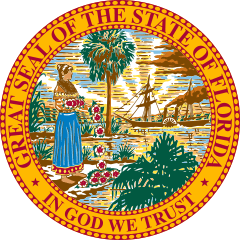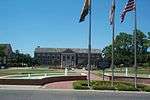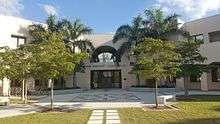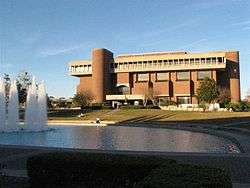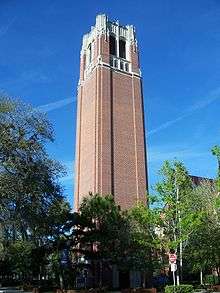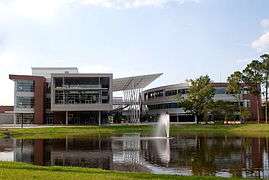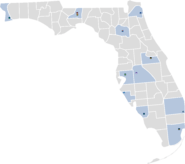State University System of Florida
The State University System of Florida (SUSF or SUS) is a system of twelve public universities in the U.S. state of Florida. As of 2018, over 341,000 students were enrolled in Florida's state universities.[1] Together with the Florida College System, which includes Florida's 28 community colleges and state colleges, it is part of Florida's system of public higher education. The system, headquartered in Tallahassee,[2] is overseen by a chancellor and governed by the Florida Board of Governors.
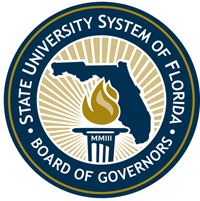 | |
| Type | Public University System |
|---|---|
| Established | 1905 |
| Chancellor | Marshall Criser III |
| Students | 341,000 (2018) |
| Location | , , U.S. |
| Campus | 12 Member Institutions |
| Website | www |
The Florida Board of Governors was created in 2003 to centralize the administration of the State University System of Florida. Previously, Florida's State University System had been governed by the Florida Board of Regents (1965–2001) and the Florida Board of Control (1905–1965).
History and governance
Prior to 1905, Florida's state institutions were governed by a Board of Education and even earlier variations thereof, reaching back to the Florida Constitution of 1838 wherein higher education and normal education was established, based on grants of land from the U.S. Congress. From 1905 to 1965, the few universities in the system were governed by the Florida Board of Control. The Board of Control was replaced by the Florida Board of Regents in 1965, to accommodate the growing university system. The Board of Regents governed until it was disbanded by the Florida Legislature in 2001, and its authority was divided between the Florida Board of Education (which was given some authority over all levels of public education in the state), and appointed university boards of trustees, which operated independently for each separate institution. In 2002, Floridians led by U.S. senator Bob Graham passed an amendment to the Florida Constitution establishing a new statewide governing body, the Florida Board of Governors.
| Term | Chancellor |
|---|---|
| 1954–1968 | J. Broward Culpepper |
| 1968–1975 | Robert B. Mautz |
| 1975–1980 | E.T. York |
| 1981–1985 | Barbara W. Newell |
| 1985–1998 | Charles B. Reed |
| 1998–2001 | Adam W. Herbert |
| 2001 | Judy G. Hample |
| 2003–2005 | Debra D. Austin |
| 2005–2009 | Mark B. Rosenberg |
| 2009–2013 | Frank T. Brogan |
| 2014–present | Marshall Criser III |
Chancellors of the State University System |
 |
Member institutions
| Institution | Location | Established |
|---|---|---|
| Florida A&M University | Tallahassee | 1887 |
| Florida Atlantic University | Boca Raton | 1961 |
| Florida Gulf Coast University | Fort Myers | 1991 |
| Florida International University | Miami | 1965 |
| Florida Polytechnic University | Lakeland | 2012 |
| Florida State University | Tallahassee | 1851A |
| New College of Florida | Sarasota | 1960 |
| University of Central Florida | Orlando | 1963[3] |
| University of Florida | Gainesville | 1853A |
| University of North Florida | Jacksonville | 1972 |
| University of South Florida | Tampa | 1956 |
| University of West Florida | Pensacola | 1963 |
^A In 1851, the Florida legislature voted to establish two seminaries of learning: West Florida Seminary (which later became Florida State University) and East Florida Seminary (which later became the University of Florida).[4] In 1905, when the Buckman Act reorganized higher education in Florida, the three resulting state institutions all adopted 1905 as their founding date. In 1935 the Florida Board of Control changed the founding dates of UF and Florida State to the years their predecessor Seminaries opened: 1853 and 1857, respectively. In 2000, Florida State declared 1851 to be its founding date, reflecting the date the legislature authorized both seminaries. In 1836, the United States Congress authorized the establishment of a University of Florida in the Florida Territory, to be located on lands reserved in both East and West Florida.[5]
| SUS Student Enrollment | ||
|---|---|---|
| Year | Students | %± |
| 1905 | 620 | — |
| 1910 | 835 | +35% |
| 1915 | 1,341 | +61% |
| 1920 | 1,882 | +40% |
| 1925 | 3,688 | +96% |
| 1930 | 4,655 | +26% |
| 1935 | 5,550 | +19% |
| 1940 | 6,395 | +15% |
| 1945 | 7,020 | +10% |
| 1950 | 19,015 | +171% |
| 1955 | 19,847 | +4% |
| 1960 | 27,053 | +36% |
| 1965 | 43,849 | +62% |
| 1970 | 73,676 | +68% |
| 1975 | 115,334 | +57% |
| 1980 | 128,578 | +11% |
| 1985 | 146,692 | +14% |
| 1990 | 179,775 | +23% |
| 1995 | 208,493 | +16% |
| 2000 | 240,753 | +15% |
| 2005 | 287,375 | +19% |
| 2010 | 321,503 | +12% |
| 2011 | 329,737 | +3% |
| 2012 | 334,989 | +2% |
| 2013 | 337,750 | +1% |
| 2014 | 341,044 | +1% |
| 2015 | 345,672 | +1% |
| 2016 | 352,116 | +2% |
| 2017 | 358,519 | +2% |
| Sources:[6][7] | ||
Gallery
See also
References
- "System Accountability Report Summary" (PDF). Retrieved September 24, 2018.
- "Contact Us." State University System of Florida. Retrieved on August 26, 2011. "Florida Board of Governors State University System 325 West Gaines Street, Suite 1614 Tallahassee, Fl 32399-0400"
- "Facts About UCF". UCF Office of Institutional Research. Archived from the original on April 15, 2012. Retrieved December 7, 2008.
- "Timeline". The Florida Memory Project. State Library and Archives of Florida. 1851. Archived from the original on August 1, 2010. Retrieved July 9, 2010.
- Memorial of the Trustees of the University of Florida (R.K. Call, John G. Gamble, Thomas Randall, Louis M. Goldsborough, Thos. Eston Randolph, F. Eppes, E. Loockerman, Benjamin Chaires, Turbutt R. Betton, Fitch W. Taylor, J. Loring Woart, Ashbeel Steele, J. Edwin Stewart), p. cxxiii. United States Congress. December 7, 1835. Retrieved December 13, 2013.
- "State University System of Florida | Board of Governors : Resources". Flbog.edu. Retrieved August 23, 2014.
- "Enrollment data". www.flbog.edu. Retrieved May 15, 2019.

